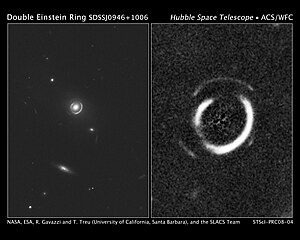
SDSSJ0946+1006 is an unusual gravitational lens system consisting of three galaxies at distances of respectively three, six, and eleven billion light years from Earth. In a report presented at the 211th meeting of the American Astronomical Society, researchers Raphael Gavazzi and Tommaso Treu of the University of California, Santa Barbara described the discovery of a double Einstein ring produced by the gravitational lensing of light from two distant galaxies. The observations were made using the Hubble Space Telescope.
The main lens lies at redshift z = 0.222, with the inner ring at z = 0.609 with an Einstein radius RE = 1.43±0.01" and magnitude m = 19.784±0.006, the outer ring is at z ≲ 6.9 with RE = 2.07±0.02" and magnitude m = 23.68±0.09 The lensing galaxy is also known as SDSSJ0946+1006 L1, with the nearer lensed galaxy as SDSSJ0946+1006 S1, and the farther lensed galaxy SDSSJ0946+1006 S2.
References
- arXiv preprint: Gavazzi, Raphael; Treu, Tommaso; Koopmans, Leon V. E.; Bolton, Adam S.; Moustakas, Leonidas A.; Burles, Scott; Marshall, Philip J. (2008). "The Sloan Lens ACS Survey. VI: Discovery and Analysis of a Double Einstein Ring". The Astrophysical Journal. 677 (2): 1046. arXiv:0801.1555. Bibcode:2008ApJ...677.1046G. doi:10.1086/529541. S2CID 14271515. (1.08 MB) 2-Feb-2008
External links
- HubbleSite Hubble Finds Double Einstein Ring January 10, 2008 10:00 AM (EST)